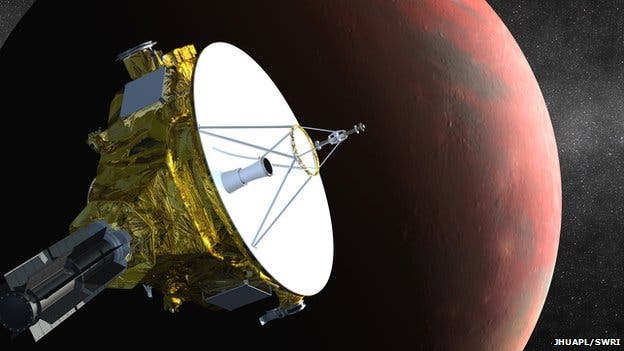
NASA’s New Horizons spacecraft is currently seven years into its nine-and-a-half-year journey across the Solar System to explore Pluto. Since its launch in 2006, however, astronomers have discovered two more moons orbiting the dwarf-planet, which now pose a grave threat to the spacecraft’s initial navigation course because of space debris orbiting them.
“We’ve found more and more moons orbiting near Pluto – the count is now up to five,” said Dr Alan Stern, chief scientist on the New Horizons mission.
“And we’ve come to appreciate that those moons, as well as those not yet discovered, act as debris generators populating the Pluto system with shards from collisions between those moons and small Kuiper Belt objects.”
Scientists are currently devising alternative routes which will stir the spacecraft out of harms way, while at the same time preserving the mission’s integrity.
“We want people to understand just how interesting and how nail-biting New Horizons’ mission might be,” said Stern. “This is part of the excitement of first-time exploration, of going to a new frontier.”
Space debris have always been a grave issue for NASA spacecrafts exploring deep in the solar system – currently New Horizons is 24 times farther away from the sun than Earth is, only 1,000 days away and 730 million miles (1,180 million kilometers) from closest approach to Pluto. Since it’s travelling at a whooping fast velocity – more than 30,000 miles per hour – a collision with a single pebble, or even a millimeter-sized grain, could ruin the spacecraft beyond recovery. All these years, billions of dollars, and heartfelt passions could all be in vain, if a disaster isn’t averted.
With this in mind, NASA scientists are had at work tinkering solutions. The primary objective is currently identifying space debris in Pluto’s orbit using computer simulations, ground-based telescopes and the Hubble Space Telescope. Meanwhile, the team is also plotting alternative, more distant courses through the Pluto system that would preserve most of the science mission.
“We’re worried that Pluto and its system of moons, the object of our scientific affection, may actually be a bit of a black widow,” Stern said. “We’ve come to appreciate that those moons, as well as those not yet discovered, act as debris generators populating the Pluto system with shards from collisions between those moons and small Kuiper Belt objects.”
An interesting safety precaution NASA engineers are currently considering is pointing New Horizons’ antenna dish forward, “to act as a meteorite shield to protect the spacecraft from impacts,” Stern said. “This technique is not new — the Cassini probe used that when crossing Saturn’s ring plane as well.”
The latest the research team can alter the spacecraft’s trajectory is about 10 days before it gets to Pluto. That gives NASA scientists a few years to plot the best course for New Horizons.
“After that, there’s not enough fuel to make a change,” Stern explained. “We don’t often get into situations in spaceflight where we have to make last-minute decisions. We’re going to learn as much as possible before our final approach in 2015.”
Was this helpful?



